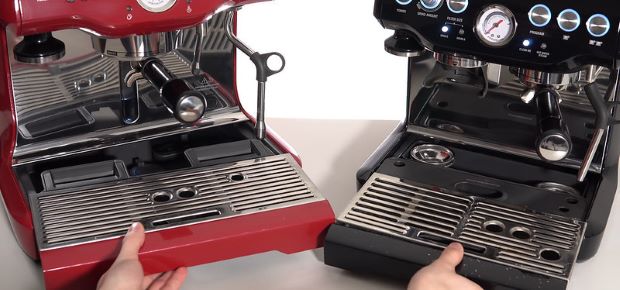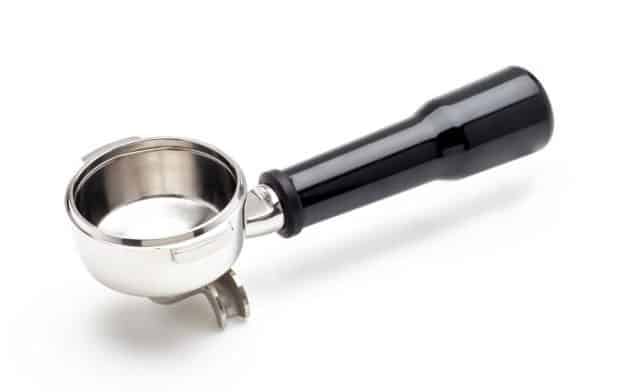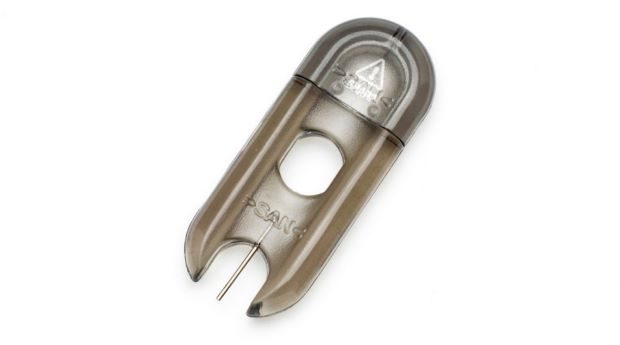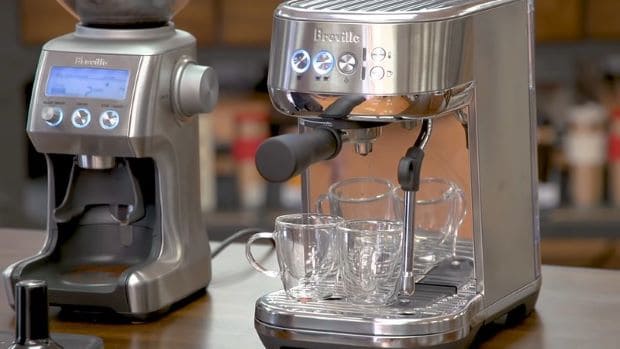Last Updated on December 3, 2023
If you want to keep your Breville espresso machine in top shape, you have to clean it thoroughly and often.
Depending on the model you own, the cleaning process can be a bit tougher than it is with other coffee makers.
This easy-to-follow cleaning guide will explain how often to clean each component of your Breville espresso machine—from the portafilter to the drip tray—so you can enjoy a great shot of espresso every day.

Why Cleaning Your Espresso Machine Is Important
By cleaning your Breville machine regularly, you’ll improve your coffee-making experience in the following ways:
- Flavor consistency. As gunk and minerals build up inside the water tank or steam wand, they can affect your espresso’s flavor balance. If you notice that your coffee has a funny taste or tastes a little off, that’s a sure sign that it’s time for cleaning duty.
- More efficient operation. Clean components work better than dirty ones, so maintaining a regular cleaning schedule helps to prevent excess wear and tear. And when you take the machine apart, you can spot potential issues that could cause problems in the future.
- Longevity. The best Breville espresso machines are built to last years, but a lack of cleaning and maintenance will shorten the machine’s lifespan dramatically. The more often you use the coffee maker, the more often you have to clean it.
How Often To Clean Your Breville Espresso Machine
You should clean your Breville espresso machine every time you use it. Some components—such as the water tank—don’t get very dirty with each cup of coffee, so you can wait longer to clean them.
Let’s break down the cleaning steps for each part of your coffee maker.
How To Clean Your Breville Espresso Machine Parts
Cleaning the Portafilter

After each use, remove the portafilter and dump out any remaining coffee grounds. Take out the filter basket and use warm water to wash out leftover grounds that get stuck inside the pieces. We recommend using a nylon scrub brush (metal will leave scuff marks) to get into the nooks and crannies.
Once the portafilter is visibly clean, brew plain hot water for about ten seconds to remove any coffee residues, oils, or other residues. Repeat these steps again if necessary.
Cleaning the filter holder every time should prevent any buildup.
Cleaning the Drip Tray
High-end espresso machines will usually have an Empty Me sign that pops up when the drip tray is full of water. Even if you’re not spilling any coffee, the tray fills with condensation from the pipe at the back of the machine. Typically, the sign will pop up after a couple of weeks, depending on how often you brew coffee. If your Breville espresso machine is leaking, it’s often because the drip tray is full.
Pull the tray out and empty it into the sink. Then pull the grate off and wipe it down with a damp towel. Rinse the rest of the tray off with warm water and dry it with a regular towel. If you notice any dirty spots or residue, you should scrub the surfaces with a sponge and soapy water.
Cleaning the Steam Wand
Remove the wand and pull out the froth enhancer. Rinse both pieces and put them back on the machine. Then select the steam option and run it for several seconds. Doing this helps to blow out any remaining milk that may be inside the wand.

Your espresso machine should have come with a steam wand cleaning tool (like the one pictured above), which has a narrow end that fits into the wand. If you don’t have it, we recommend a soft-bristled straw cleaning brush instead. Use soap or a cleaning solution and run the brush through the wand several times. Rinse everything thoroughly afterward.
Another Cleaning Method: Using a Cleaning Tablet
One of the best things about a Breville espresso machine is that you can use a cleaning tablet to clean the inside of the appliance. Put the tablet in the special insert that comes with the single portafilter, lock it in, and choose the cleaning cycle.
The tablet should flush out any residue or oils that are still in the machine. This process works much better than running hot water through the coffee maker, but you shouldn’t have to do it more than once a month (unless you’re brewing lots of coffee).
Descaling Cycle for Your Breville Espresso Machine
The descaling cycle is another great way to clean your appliance. Over time, limescale and other mineral buildup occurs inside the coffee maker, which can cause your Breville espresso machine to not reach pressure. While a tablet flush can help alleviate this problem, it doesn’t descale any existing residue. For that, you’ll need a descaling cleaning solution. You can find these for sale online.
Pour the descaling solution into your water tank and set your machine to the descaling setting. Run the solution through both the main drip nozzle and the steam wand. The whole descaling process should take a few minutes.
Empty the water tank once you’re finished with the entire descaling cycle, then wash the water tank to remove all remaining chemicals.
Alternatively, you can keep your Breville espresso machine clean by wiping everything down with a damp cloth regularly. Since the coffee maker is built of stainless steel, it should hold up well over time.
Changing the Water Filter on Your Breville Espresso Machine
The water filter on a Breville espresso machine should be changed every two months. However, when you descale your machine, you should change the water filter immediately. This is because the water filter soaks up descaling solution during the process.
Pull the filter holder out of the reservoir and pop the bottom off. Take the old filter out.
Soak the new filter in fresh water for five minutes, then insert it into the filter holder and reassemble. Place the device back in the reservoir. You are now good for another two months.
Tips and Tricks for Cleaning Your Breville Coffee Machine
To make cleaning your machine even easier, follow these tips:
- Use a microfiber towel on the drip tray. Doing this helps to prevent spills from clogging the machine.
- Run a brewing cycle with just plain hot water regularly. Running fresh water through the system can often keep limescale from building up.
- Follow proper brewing instructions. Be sure to read the user manual for Breville’s guidelines on cleaning and maintenance. The user manual is incredibly helpful, since the manufacturer always gives the best cleaning advice.
Overall, it’s pretty easy to keep your Breville espresso maker in good condition with regular maintenance and basic cleaning tasks. A daily cleaning, if you can manage it, will improve the taste of coffee you make. Even a weekly cleaning can do a lot for your machine’s lifespan.
Now that you know how (and how often) to clean your machine, you can enjoy high-quality cups of coffee every day!
Thumbnail image: © Angela CoffeeRank | Creative Commons


